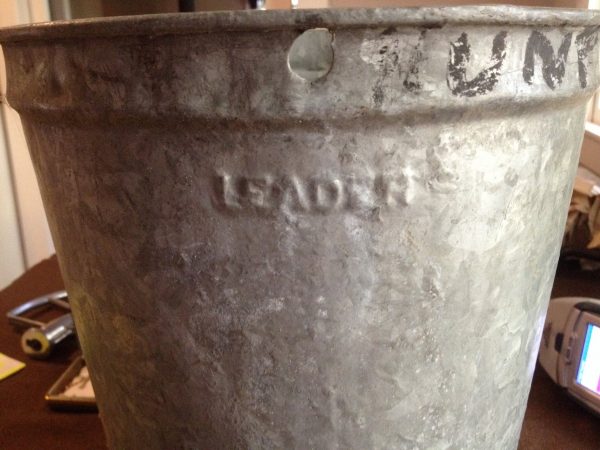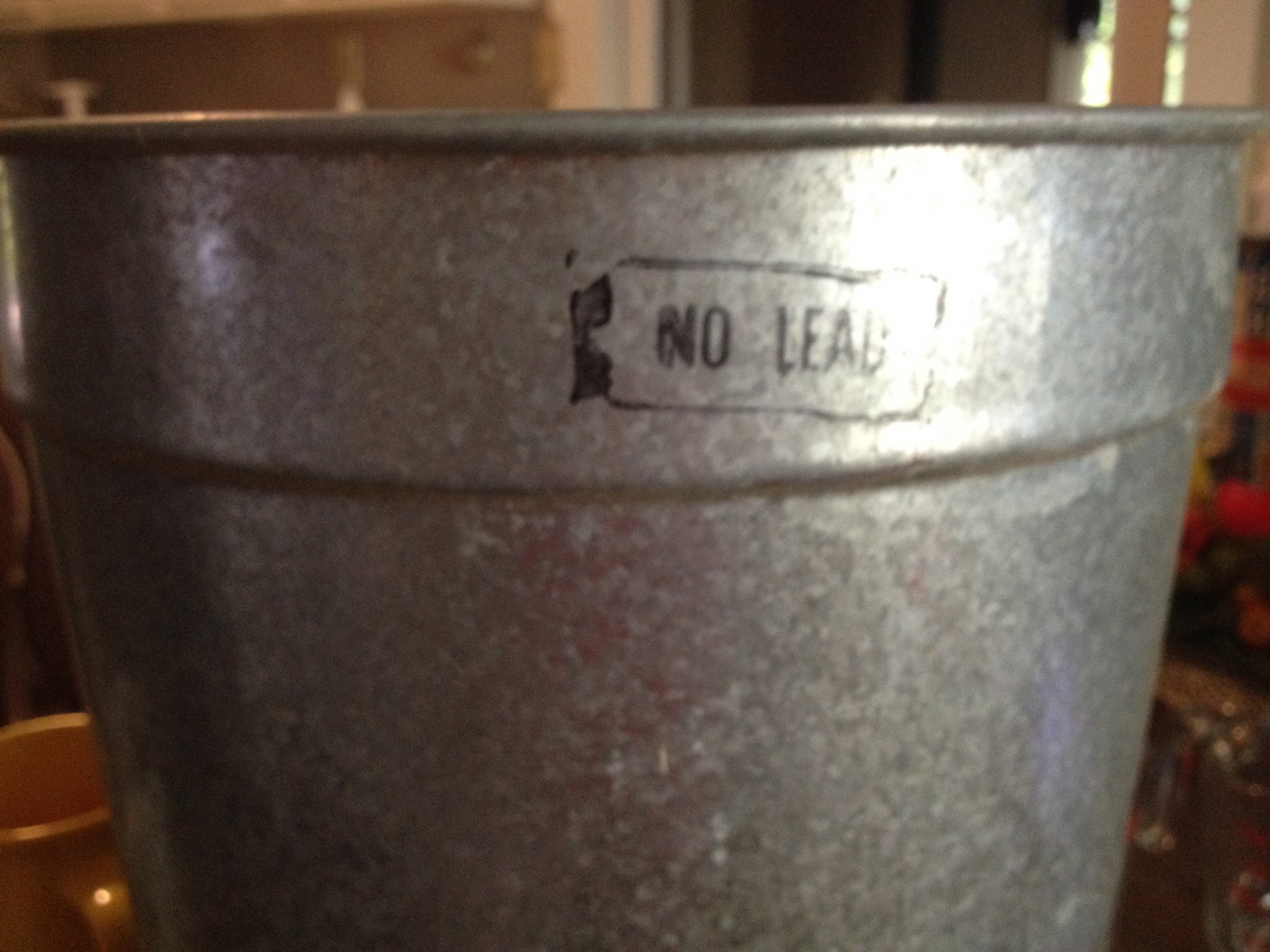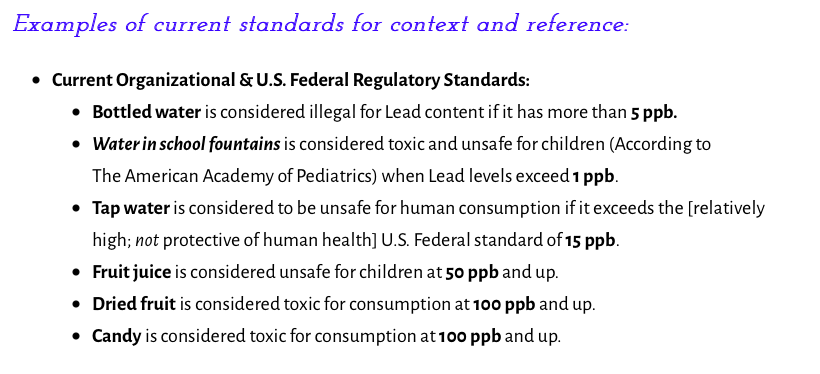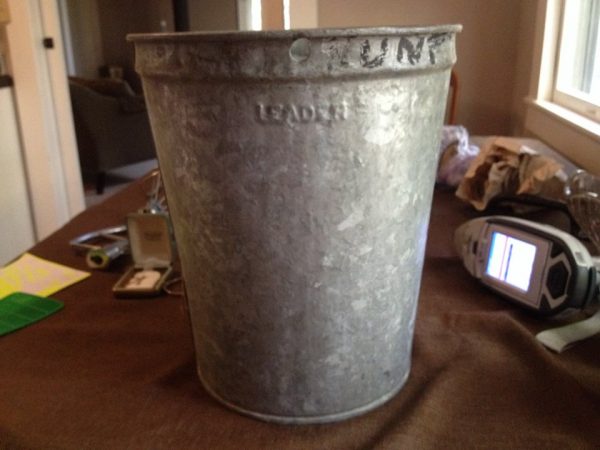I was really sad when (in 2014) I discovered that this antique maple syrup bucket was positive for 12,500 ppm Lead!
For those new to the Lead Safe Mama website:
Tamara Rubin is a multiple-federal-award-winning independent advocate for childhood Lead poisoning prevention and consumer goods safety, and a documentary filmmaker. She is also a mother of Lead-poisoned children (two of her four sons were acutely Lead-poisoned in 2005).
- Tamara owns and runs Lead Safe Mama, LLC — a unique community collaborative woman-owned small business for childhood Lead poisoning prevention and consumer goods safety.
- Since 2009, Tamara has been conducting XRF testing (a scientific testing method) using the exact instrumentation employed by the U.S. Consumer Product Safety Commission to test consumer goods for toxicants (specifically heavy metals — including Lead, Cadmium, Mercury, Antimony, and Arsenic).
- Since July of 2022, the work of Lead Safe Mama, LLC has been responsible for 5 product recalls (FDA and CPSC).
- All test results reported on this website are science-based, accurate, and replicable.
- Items that Lead Safe Mama, LLC reports on are tested multiple times to confirm the results published (for each component tested).
- Recent notable press… There has been too much to mention already in 2024! Please check out our press page to see some of the amazing coverage of our work so far this year!
Originally published: 2014
Re-shared: November 21, 2017
Updated: October 25, 2020
Antique/ vintage maple syrup collection bucket from New Hampshire,
“Leader” brand: 12,500 ppm Lead.
This item is possibly 60 or 70 years old (as of 2014).
When I tested this antique maple syrup bucket in 2014 I was more than disappointed to learn it was positive for a very high level of Lead.
Why is this a problem?
Given these buckets are typically made of galvanized metal and the Lead is on the surface (as demonstrated by the fact these items quickly test positive with a reactive agent home test kit like a LeadCheck® swab), this means that there is a high likelihood of transfer of Lead contamination from the bucket to the syrup contained within the bucket.
Not only is there a likely transfer of Lead to the food, but this is the FIRST STEP in the process of harvesting maple syrup (collecting the sap in a bucket). From here, the product is slowly heated to evaporate the moisture content of the sap — which means any Lead may actually be concentrated during with the process of concentrating the sap and turning it into the high-sugar end product of syrup.
What’s the solution?
Unfortunately, one might think that the solution is to use a newer maple syrup bucket (and — no matter what — avoid vintage or antique manufacturing and harvesting equipment when farming). This is only partly a solution, however, I have found that newer maple syrup sap collection buckets may also have unsafe levels of Lead (also in the surface of the galvanized metal bucket, the surface that touches the food)! This is even true for galvanized syrup harvesting buckets that are marked “Lead Free!!!!” If you click this link you will see an example of a new Maple Syrup bucket (marked “No Lead”) that tested positive for 405 ppm Lead with an XRF instrument. Ideally, if there was some way we (as consumers) could convince maple syrup manufacturers to only use stainless steel (non-galvanized) buckets (as well as using stainless — or other truly Lead-free equipment — for all other equipment in the process), that would be excellent!
How much Lead is “too much” Lead?
For context, the amount of Lead considered unsafe (and illegal) in products “intended for use by children” is anything 90 ppm or higher in the paint, glaze, or coating, and anything 100 ppm or higher in the substrate (in the case of a mug for instance, this would be the base ceramic of the mug). These standards are for XRF-detectable total Lead content (not leach-test results, which is a different standard/ type of testing).
Unfortunately, food manufacturing and preparation equipment (including maple syrup/ sap collection buckets) are not regulated in the same way (with the same strict standards) as children’s items — as they are not considered “items intended for use by children.” This lack of regulatory standards is why a newer bucket can — rather unbelievably — be labeled “Lead-Free” and still test positive for Lead with XRF technology.
In my opinion, this is a significant regulatory loophole — as children eat food (of course) — and especially in this case, as frankly, I don’t know any children who don’t love maple syrup! As discussed in my film, unfortunately, processed food products — and even organic processed food products (like wine, chocolate and maple syrup) — have the potential for Lead to be added at every step of the manufacturing process with the metal substrates and painted coatings of harvesting and processing equipment being a significant contributing factor to the Lead content in these products.
“What have you decided to do about this, Tamara?”
- For my family, I always buy organic (which really may make no difference in avoiding Lead, but buying organic in general helps me avoid the additional personal and environmental burden of many of the worst insecticides, herbicides, fumigants, and a host of other toxic chemicals routinely used in large-scale mainstream agribusiness today — and it also makes me feel better about doing something positive to support small family farmers).
- I also always buy my maple syrup in glass (again — this has no bearing on whether or not the syrup was potentially contaminated in the manufacturing process, but limits the potential toxicant contamination to the syrup from plastic containers).
- I also have decided to allow organic maple syrup (packaged in glass) in our lives and just make sure it is not used often. When we do use it, we use it sparingly. (However, given what I just learned as of October 2020 — see below — I am rethinking that decision.)
Feedback from my readers
Sunday, October 25, 2020
After re-sharing this piece on Facebook (October 25, 2020), I got some additional great feedback and information (links) from my readers and friends. Here’s what was shared with me:
-
- Christopher said, “Considering maple sap is generally acidic (6.5ish), this is a problem.” He followed up with this link: https://www.clemson.edu/extension/food/food2market/documents/ph_of_common_foods.pdf
- Christopher also shared this link about maple syrup acidity: https://blog.hannainst.com/ph_maple_reverse_osmosis
- Jordan said: “Our state lead specialist (Vermont) has seen families poisoned indubitably from syrup – more likely from the actual boiling pan as so many of them are ancient and soldered! Many small and all Large-scale maple ops use plastic tubing rather than buckets, which are only used in very small home operations these days.”
- Gina responded with, “It’s a requirement that certified organic maple syrup is processed with lead-free equipment.”
- Gina also shared this link: Guidelines for Certification of Organic Maple Sap & Syrup
- Note: While I was happy to hear that there are regulatory standards when it comes to Lead in the organic certification of Maple Syrup in Vermont, I reiterated (in response to Gina’s comments) that (as noted above) even equipment marked “Lead-Free” or “No Lead” can have Lead (per the second maple syrup bucket example published on this website — linked here).
- Also in reading the document linked in point #5 above, I was horrified to learn that as long as Maple Syrup is below 250 ppb Lead it is allowed to be considered organic (with other organic standards followed). This is not okay! A reading of 250 ppb Lead is simply FAR TOO HIGH for any food standard — and definitely for an acceptable amount of Lead in an organic food item! Candy and dried fruit are considered toxic and unsafe for children when Lead levels are in the 50 to 100 ppb range. Water is considered toxic with Lead levels above 1 ppb (AAP standard) or 5 ppb (U.S. Federal standard for bottled water) or 15 ppb (U.S. Federal standard for tap water). Organic maple syrup should be at least required to meet or exceed the standards of (not-organic!) dried fruit and candy!
In light of the above revelation (in point #7), I think it would be prudent to confirm that your provider of organic maple syrup does not use any galvanized, brass or otherwise Leaded equipment, and that they have made the transition to full stainless (or at least fully Lead-free) operations. I would also want to see the Lead test results for their syrup and would personally not be comfortable consuming maple syrup unless the level was below 50 ppb Lead (similar to the concerns with salt). Additionally, I am also hesitant about the use of plastic equipment in manufacturing (particularly manufacturing that involves heating the food product), so that’s another set of considerations/ another inquiry!
Continue reading below the image:
Thank you for reading and sharing this work.
There is literally no one else on the planet doing what I do (using highly-accurate and precise XRF technology to test consumer goods of all types — as suggested by YOU, the readers — and reporting the results on our website so this information is freely available to the public and parents can be informed when making safer choices for their families). To make a contribution in support of this independent consumer goods testing and Lead poisoning prevention advocacy, click here.
Tamara Rubin
#LeadSafeMama
Amazon links are affiliate links. If you purchase something after clicking on an affiliate link, Lead Safe Mama, LLC may receive a small percentage of what you spend at no extra cost to you.
Never Miss an Important Article Again!
Join our Email List














Wow, who knew…but now lots of us do know, and know to be very careful…so thankful for what you do for all of us to be safe(r) from lead!
Thank you for your kind words, Dawn!
Tamara
I buy barred woods maple syrup. They use at least some stainless steel but I haven’t contacted them for specific details. They mention it in their post about the building of their new sugar house and there are pictures of the stainless steel. Doesn’t mean no lead but it’s a start?
https://barredwoodsmaple.com/blogs/news/open-for-business-barred-woods-maple-new-sugarhouse
This info needs to get to state senators and congressmen in maple syrup producing states. There is always going to be someone opposed to regulations but the state that could promote its syrup as truly lead free would surely have a big market advantage.
Not being very technically savvy, what would be the link to this post if I wanted to send it to my Senators and Congressmen and women? Virginia does produce a small amount of maple syrup.
Mimi
Shoot! We just planted some raised garden beds in galvanized metal and now fear that we are contaminating the soil and what we are growing with lead.
https://agnr.osu.edu/sites/agnr/files/imce/pdfs/maplesyrup/KeepingLeadOutofMapleSyrup.pdf
Found this nugget about recommendations on lead in syrup…love the part where they advise filtering out the lead in the ‘sugar sand’ portion which can be as high as 1 million ppb
What’s also scary to me is honey production. I’ll be been many local park districts and local operations/farms in the Midwest that go in and rescue bees from in between walls of 100 year old leaded homes to start their hive, ive seen the gross pics. Then they sell all the hive products as food, It’s terrifying really.
Have you tested any maple syrup like Costco organic or anything?
Thank you for the work you do!
Hi Angela – I don’t actually have the capacity to test food products. The instrument I use cannot test liquids and only tests down to single digit parts per million. Food can be toxic in the parts per billion range (single digit to double digit) so a much more sensitive testing methodology is needed in most cases.
Tamara
I am throwing out yet ANOTHER organic food item! Thank you Tamara!!!
Hello and thank you! I know that you now test food as well, so do you know of any safe choices for maple syrup?
Not yet – not that we have sent the lab
This is what barred woods said when I asked them if they have tested for lead or other contaminants: “As part of our organic certification process, we are not allowed to use lead containing materials on anything that touches the raw sap or maple syrup. Additionally, our organic certifier (NOFA-Vermont) may choose to randomly sample and test our products for contamination. I’m happy to report, we have never failed an inspection!”
Not a amazing answer…like Tamara said even the certificatcation allows too high of lead levels and buckets labeled no lead still contain it. I might challenge it and ask for further questions.
I don’t eat sugar and I can’t eat honey. I usually use maple syrup for sweetener or when cooking. What sweetener do you recommend for me to use that isn’t filled with toxins?